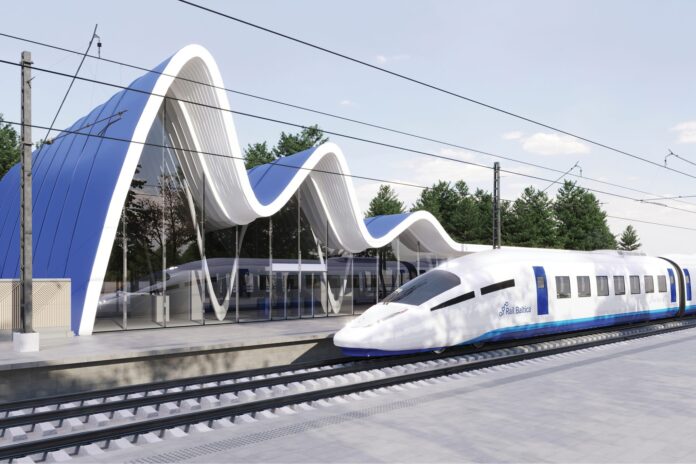The cost of the first stage of the international Rail Baltica project in the Baltics could reach EUR 15.3 billion, of which EUR 6.4 billion in Latvia, while the total project cost could reach EUR 23.8 billion, Csaba Bakos, a representative of the Boston Consulting Group, a cost-benefit analyst, told reporters on Monday.
A previous cost-benefit analysis in 2017 estimated the total cost of the project at EUR 5.8 billion.
This included an increase of around 18 percent or EUR 3.2 billion due to additional external requirements and factors such as third-party requirements, various institutional technical regulations, technical specifications for interoperability and other changes, and an increase of 31 percent or EUR 5.7 billion due to the expansion of the project’s scope, including the inclusion of regional stations, changes in technical standards in line with common design guidelines and increased requirements for infrastructure safety and performance, while 51 percent or EUR 9.2 billion of the increase is due to more accurate cost estimates now that design is in its final phase and value engineering has been carried out along the entire route.
The calculation also includes the impact of 40 percent inflation since 2017 on the project’s cost.
At the same time, the updated Cost-Benefit Analysis concludes that the Rail Baltica project is economically viable and is expected to increase Gross Domestic Product (GDP) by 0.5 to 0.7 percentage points per year, delivering an indirect GDP increase of EUR 15.5 to EUR 23.5 billion for the Baltic countries.
The project will also have a direct net economic benefit value of EUR 6.6 billion. The wider economic benefits include military mobility, environmental sustainability, reduction of social inequalities, new trade flows and supply chains with Europe.
The project has evolved significantly since the previous cost-benefit analysis in 2017 and has been influenced by both external and internal factors, including inflation, Bakos explained. The first phase of the project, which aims to build the Rail Baltica high-speed rail line in all three Baltic states, connecting to Poland, by 2030, is estimated to cost EUR 15.3 billion. In Latvia, the cost could reach up to EUR 6.4 billion.
Rail Baltica is estimated to cost EUR 26 million per kilometer. The study shows that the average cost per kilometer for similar high-speed rail projects in Europe is EUR 24 million and can reach up to EUR 35 million per kilometer.
The main findings of the study show that passenger transportation will contribute 80 percent of Rail Baltica’s benefits, environmental improvements – 14 percent and freight – 5 percent. The new high-speed rail link will integrate the Baltic region into the European rail network, generating a projected GDP growth of 0.5-0.7 percentage points per year. The main drivers of economic growth are increase of real estate value, tourism, new business development, productivity and competitiveness gains, and the development of urban centers. By 2046, Rail Baltica is estimated to handle 51.7 million passengers and 10.9 million tons of freight.
Rail Baltica will create new trade flows and supply chains with Europe and will be an important link in the reconstruction of Ukraine. The project will also improve energy security and promote the transition to renewable energy, reducing annual consumption of fossil energy, including fuel, by 1.5-3.3 percent and contributing to the achievement of the European Green Deal targets. The project will also improve environmental and road safety by reducing pollution and the risk of traffic accidents.
The cost-benefit analysis also shows a positive impact in terms of reducing social inequalities and ensuring access to public transport for 351,000 people from low-income groups and 59,000 passengers with reduced mobility.
Rail Baltica’s contribution to safety and security is of strategic importance. For military logistics, it has been estimated that in peacetime one 40-car train can replace a seven-kilometer convoy of military equipment.
In order to maximize the socio-economic benefits for the Baltic region, it is essential to build all the infrastructure elements planned in the Rail Baltica project, implementing the full scope of the project. However, given the ambitious cost increases, the project needs to be implemented in a phased and prioritized manner, the analysis concludes.
The first phase of the project is planned to be implemented by 2030 according to the timetable set out in the Trans-European Transport Network program, creating a high-speed corridor between the Polish border and Tallinn.
After 2030, the construction of the second phase of the Rail Baltica project will depend on the availability of funding. The total cost of the full scope of the project could reach EUR 23.8 billion.
With funding from the Connecting Europe Facility, Rail Baltica has already secured EUR 2.7 billion in financing in the Baltic states, while the project has applied for a total of more than EUR 2 billion for the tenth call for projects.
The EU funding beyond these sources will largely depend on the negotiations on the next EU multiannual budget. RB Rail, the central coordinator of Rail Baltica, is currently analyzing with the implementing organizations other possible sources of funding, including attracting private investors.
In Latvia, an international tender has selected a builder and a structural engineer for more than 200 kilometers of the main line and preparations are underway for the southern section to start construction on the first 13 kilometers.
The Cost-Benefit Analysis was carried out by the Rail Baltica joint venture RB Rail in cooperation with external international consultants.
Source: BNS
(Reproduction of BNS information in mass media and other websites without written consent of BNS is prohibited.)

